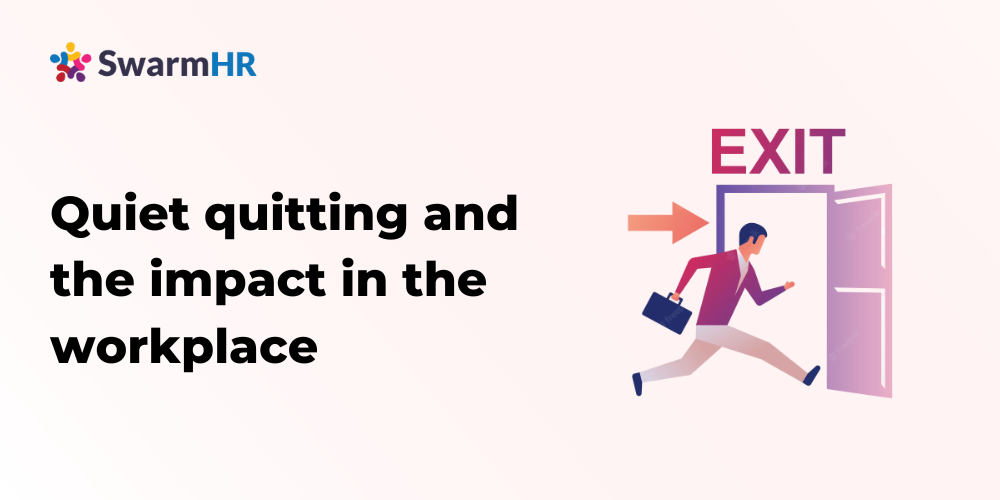Quiet quitting and the Impact in the Workplace

A trend that has “dominated” social media, especially TikTok. In July, Zaid Khan, a 24-year-old engineer from New York, posted a video about quitting, and it went viral. Since then, the trend has spread like wildfire with hashtags like #quietquitting, #quitting, and #quieting. Making a huge impact in many parts of the business world. Many have stated this as a fake trend because of this debate and trends on it mainstream media began to cover it.
Covid was that moment when people began to ask a larger questions like “What do I want out of life?”, “Do I want to continue working the way that I have?” Or “do I want something different?”, “Do I want to continue to work? Which is awesome, But do I also want to be able to enjoy my family?”, “ Do I also want to be able to enjoy my life?”. So, all these things are coming in stages, and quitting is just the trend that’s come as a result of the “ultimate reset,” which is COVID. According to Gallup’s report “State of the Global Workplace” published in 2022, the global cost of low employee engagement is $7.8 trillion. As is already seen, companies are faced with an increase in quiet quitting and, thus, a decrease in employee engagement.
In order to discuss trends, let’s first talk about quiet quitting.
What is quiet quitting?
It is the latest workplace trend, and it does not involve silently resigning or slipping your resignation letter under your boss’s door. Quite quitting is a form of employee disengagement about quitting the idea of going above and beyond your KRA (key responsibility area) at work or without taking on any extra duties, or participating in extracurriculars at work(non-office hours).
The Trend of quiet quitting at the workplace
This trend is basically about doing only what you’re expected to do. If your job is to lead a project, that’s all that you do. You don’t propose new projects; you don’t help others with their projects; you don’t mentor colleagues or help team building with team building exercises All you do is lead your project .
They say quiet quitting is about quitting the hustle culture. It advocates signing in at 10 and signing out at 5 doing only what you are hired for. This is something you have been told not to do at work for a long time. But today’s generation is embracing the idea of doing the bare minimum. They have dumped the idea of going the extra mile or working extra hours, taking work calls on weekends or after workouts. Gen Z is quiet and quitting .
It is being endorsed as a workers’ revolution on social channels and as a revolt against overworking at the work environment.
The trend apparently began in China, and Beijing has now banned the mention of quiet quitting, but workers across sectors are talking about it. So, how healthy is quiet quitting? In theory it may sound like the ultimate mantra for a perfect work-life balance you know, Sign in on time, sign out on time enough and this may sound like the most sustainable way to work in practice, quiet quitting may be just the opposite. This trend stands to take a toll on your life. Let’s assume that most people work because they have bills to pay. Sure, a lot of them love what they do, but they wouldn’t work pro bono or for free. What happens to these bills and to their lives if there is loss of job? and you will have a job requirement. Quiet quitting comes with that risk.
There’s a very thin line between setting healthy boundaries and being disengaged .
- It is healthy to not bite more work than you can chew, but it is unhealthy to duck at the site of work;
- It is healthy to spend time with family; it is unhealthy to sign out at five, even if they’re spending time at work.
- It is healthy to switch off during weekends and unhealthy to be flexible about it.
There it is, that’s the thin line.
Also, managers can tell when someone has crossed that line. It’s easy to figure out that someone is not putting in the same effort as they used to or when the person’s productivity falls and stays that way for a long time. Do you know what will happen next in the appraisal season? It works on Newton’s third law of motion… “Action & Reaction: you get what you give” and work is very transactional that way. If you don’t give your best, your employer won’t give you the best of opportunities. It leads to stagnation. Your bonus letters will reflect the stagnation. You see, no company wants lackluster workers. You may have noticed how such employees are often sidelined, kept out of strategy meetings, and eventually told to leave. Every trend has its good, bad, and ugly, and this is the ugly side of quitting quietly.
Experts believe this trend is a result of global burnout, and the theory makes sense. 52 percent of workers the world over are burnt out, so they’re trying to find a way to get back a sense of balance and resorting to quiet quitting as the way to do it. If you’re burned out, should you too embrace quiet quitting? Why not talk to your manager instead to figure out a way to cope with a burnout. Take a break, come back and deliver your best, but don’t let your reputation suffer by becoming the face of a demotivated worker. If you’re not satisfied with your work, discuss it with your manager. If nothing changes even after the conversation, then quit. Take up another job and give it everything, but don’t become that worker who just does the bare minimum. If you think you need to reevaluate your career, then do that. Upskill yourself and whatever new thing it is that you choose to do, be enthusiastic about it. Don’t stay in a job half-heartedly opt a job which give job satisfaction. Don’t quit quiet. It neither helps your growth nor your reputation as an employee. That said, you know your situation best. Think twice before you jump on a trend.
Catapult to digital-first organization
Learn More

03 June, 2022 5 min read
What is an LCA? (Labor Condition Application)
The Labor Condition Application (LCA) is a form employers must file with the United States Department of Labor Employment and Training Administration (ETA). Employers apply . . .

20 June, 2022 4 min read
What are Public Access Files?
Public Access Files With the compliance mandates around public access files (PAF), they continue to be a point of worry for recruiters and staffing agencies. Recognizing . . .

09 June, 2022 6 min read
How to Fill Out Form I9: What Employers Need . . .
How to Fill Out Form I9! Can you imagine being fined almost $800 because your employee forgot to sign a piece of paper? Multiply that one mistake by thousands of employees . . .




